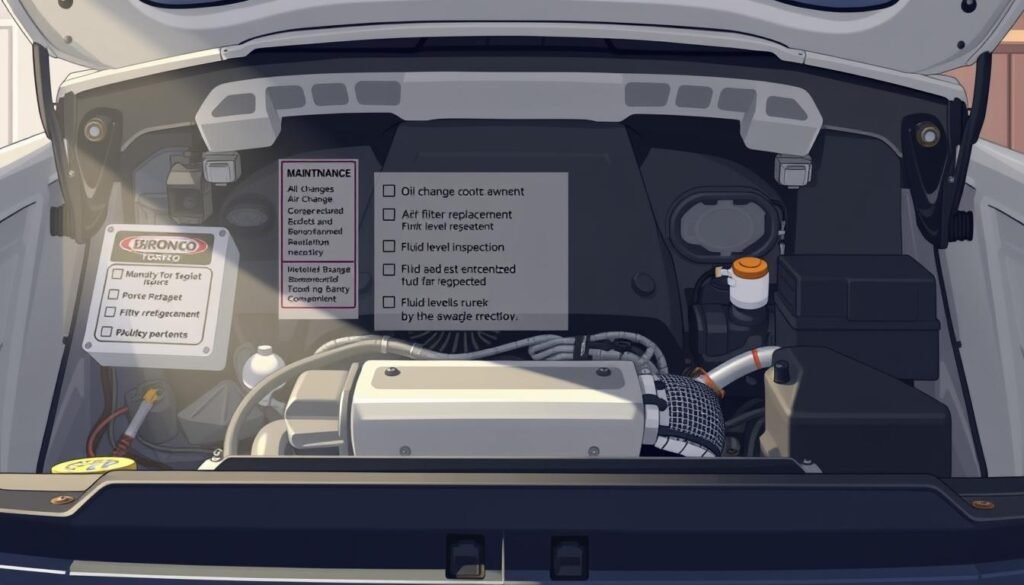Ford Bronco Maintenance Schedule Essential Guide
Knowing your Ford Bronco maintenance schedule is crucial for your vehicle’s health. Regular tasks like oil changes, tire rotations, and checking fluids keep your Bronco in top shape.
Following the suggested service times helps avoid problems and improves your driving experience.
This guide covers the key points of a complete ford bronco maintenance plan. It helps you keep up with repairs and maintenance.
We will discuss everything from regular checks to important service times. This ensures you care for your Bronco like an expert.
Being up-to-date on your ford bronco service times increases reliability and peace of mind during your journeys.
Let’s explore the details, so you can take great care of your Bronco. Enjoy every journey on the road with confidence.
Introduction To Ford Bronco Maintenance
The Ford Bronco is not just any car; it’s a symbol of adventure and discovery. Owning this versatile vehicle means you must take good care of it.
A proper maintenance plan is crucial for keeping your Bronco in top shape, especially under tough conditions.
Keeping up with scheduled maintenance is key for the best performance and reliability. Taking care of your Bronco not only improves your drive but also helps keep its value high.
Following what the makers recommend shows you value quality and care, protecting your investment.
Knowing how to maintain your Ford Bronco lets you make smart choices for its upkeep.
Importance of a Maintenance Schedule
Creating a maintenance schedule for your Ford Bronco is key to its reliable running. By sticking to a set plan, you stop small issues from turning into big, expensive fixes.
Keeping up with maintenance helps your vehicle last longer, stay safe, and run well. Without regular care, minor problems can grow, costing a lot to repair later.
A good maintenance plan lets you spot issues early. This keeps your Bronco running smoothly.
By following the ford bronco maintenance guide, you learn to do important tasks well. Adding regular checks and services to your plan boosts your car’s health.
Following advice from experts on ford bronco maintenance tips greatly improves your ride. It makes your Ford Bronco last longer and remain dependable.

What is The Ford Bronco Maintenance Schedule?
Keeping up with routine maintenance is key for your Ford Bronco’s best performance and long life.
The maintenance schedule guides you through necessary services such as oil changes, tire rotations, and regular check-ups.
By following this, you help your Bronco run smoothly and avoid future problems.
Regular Maintenance Intervals
To keep your Bronco in top shape, stick to regular maintenance intervals. The service schedule recommends essential services every 5,000 to 6,000 miles.
This approach isn’t just about changing fluids; it includes checking key components to extend your engine’s life and enhance safety.
Manufacturer Recommendations
Ford’s owner’s manual provides a detailed maintenance guide. It lists important services at different mileages, like brake checks, fluid changes, and filter replacements.
Following this guide ensures your Bronco stays in excellent condition and meets warranty standards.

Routine Maintenance Tasks For Your Bronco
Keeping your Ford Bronco in top shape means following a regular maintenance plan. Activities like changing oil and filters are key.
They help your Bronco last longer and perform better. By doing these tasks regularly, your car will stay reliable and efficient.
Oil and Filter Changes
It’s important to change your engine’s oil and filter every 5,000 to 7,500 miles. This depends on the oil type and how you drive.
Doing this keeps your engine running smoothly and prevents damage. Make sure to use the right oil grade, as suggested in your owner’s manual.
Tire Rotations and Inspections
Taking care of your tires is crucial for your Bronco. You should rotate them every 5,000 to 8,000 miles to wear them down evenly.
This helps with handling and saves gas. Checking tire tread and air pressure is also a must for your safety. Good tire care means a smoother, safer drive.

Ford Bronco Maintenance Schedule
Keeping your Ford Bronco in top shape means following a set service plan. Doing the tasks on the Ford Bronco maintenance checklist can stop problems before they start.
It also makes your car last longer and improves your drive. Here, we talk about the key things to do by the 30,000-mile mark.
Essential Tasks Before 30,000 Miles
Before you reach 30,000 miles, make sure to:
- Perform routine oil changes to keep the engine lubricated.
- Rotate tires regularly to ensure even wear.
- Inspect brakes, belts, and hoses for signs of wear or damage.
- Replace air and cabin filters for optimal airflow.
- Conduct a comprehensive inspection to identify any potential problems early.
Following these Ford Bronco maintenance tips keeps your ride ready for any journey.
Scheduled Service After 30,000 Miles
After crossing 30,000 miles, it’s vital to stick to a strict maintenance routine. This prevents big problems later on. Be sure to:
- Change the transmission fluid to maintain smooth gear shifts.
- Inspect the battery condition, replacing it if necessary.
- Replace spark plugs to keep the engine running efficiently.
Keeping up with regular check-ups helps you keep an eye on key parts like the cooling system and brakes.
By sticking to the Ford Bronco maintenance guide, you help your car perform its best for longer.

Inspecting Key Components of Your Bronco
It’s crucial to inspect your Ford Bronco regularly. This keeps its performance and safety up to par. Focus on key areas like the brakes and electrical system.
Adding these to your maintenance checklist keeps your ride smooth and secure.
Brakes and Brake Fluid
Keeping an eye on your brakes is a must for safety. Get them checked every 12,000 miles or yearly. Always check the brake fluid levels during inspection.
Change the brake fluid every three years to prevent issues. Doing so keeps your brakes sharp and responsive.
Battery and Electrical System
The battery powers everything electrical in your Bronco. Check the connections often for corrosion. Keeping the battery in good shape is key for reliable starts.
Experts suggest getting a new battery every 3 to 5 years. This helps avoid sudden car troubles.
Make sure that all electrical systems, like lights and signals, are working well for your safety.
Maintaining Fluid Levels in Your Vehicle
Maintaining the right fluid levels in your Ford Bronco is key to its best performance and long life. Checking these levels regularly helps your vehicle run smoothly.
It also avoids engine damage and overheating. The ford bronco maintenance guide stresses using the exact fluid types your owner’s manual suggests.
This includes important fluids like engine oil, coolant, transmission, and brake fluids. Also, it talks about their recommended types.
Engine Oil and Coolant Types
Engine oil helps lessen friction among engine parts, and coolant keeps the engine’s temperature just right.
Choosing the proper oil and coolant for your car is critical. The ford bronco service schedule can guide you.
To find out about the viscosity ratings and coolant types, check your owner’s manual.
Checking Transmission and Brake Fluids
Keeping an eye on your transmission and brake fluid levels is crucial for your safety. The ford bronco maintenance schedule can tell you how often to check these fluids.
Look out for any contamination or color changes as these could mean you need new fluids. Regular checks are a part of routine maintenance for ford bronco.
This makes sure your vehicle is always safe to drive.
| Fluid Type | Recommended Fluid | Check Interval |
|---|---|---|
| Engine Oil | 5W-30 Synthetic | Every 5,000 miles |
| Coolant | Ford Gold Antifreeze | Every 30,000 miles |
| Transmission Fluid | Mercon LV | Every 30,000 miles |
| Brake Fluid | DOT 3 or DOT 4 | Every 2 years |
Maintaining Air Filters For Optimal Performance
Keeping your Ford Bronco’s engine air filter in top condition is key. A clean filter keeps dirt and debris out of the engine.
This helps your car run better and use less fuel. Stick to a proper ford bronco maintenance schedule to keep it clean and working well.
You should check and maybe replace the engine air filter every 15,000 to 30,000 miles, depending on how you drive.
Engine Air Filter Replacement
Changing the engine air filter is easy and really helps your Bronco last longer.
- Find the air filter housing near the engine bay.
- Open the housing to get to the air filter. Remember how the old filter was in there.
- Take out the old air filter and see if it’s dirty or damaged.
- Put in the new air filter the right way, making sure it fits well.
- Close the housing tight.
Following these ford bronco maintenance tips leads to better engine work and fuel use.
Looking after the air filter means your car drives smoother and needs fixing less often.
Scheduling Regular Inspections
Routine inspections are key to your Ford Bronco’s performance and its long life. Getting these detailed checks yearly or every 20,000 miles offers many benefits.
They find possible issues early, stopping big problems. This keeps your Bronco dependable and safe for all your journeys.
Importance of Comprehensive Inspections
Each inspection follows a ford bronco maintenance checklist. It checks important systems like suspension and exhaust, and fluid levels.
Regular checks spot wear and tear early, making your car last longer. Fixing issues quickly saves time and money, making sure your Bronco handles any situation.
- Check suspension components for wear
- Inspect exhaust system for leaks
- Assess fluid levels in all key areas
- Examine brake systems for effectiveness
By making these ford bronco inspections a priority, you show your dedication to maintaining your vehicle. This commitment ensures a smoother and safer drive for the future.
Cost Considerations For Maintenance
Knowing what you’ll spend on your Ford Bronco’s upkeep is key for good budgeting. Regular care lessens the chances of surprise repairs.
By using a detailed ford bronco maintenance guide, you can set aside money smartly. This avoids the stress of unexpected costs.
Some usual expenses are:
- Oil changes and filter replacements
- Brake repairs and fluid replacements
- Tire rotations and replacements
- Inspection fees for key components
Staying ahead with maintenance spots small problems early. This prevents them from turning into big, expensive issues later.
It’s a smart way to save money over time. Plus, it keeps your Bronco running well. Plan a budget that covers these costs, according to the ford bronco maintenance schedule.
Being ready for regular maintenance ensures your vehicle is a wise investment.
Conclusion
Sticking to the Ford Bronco’s maintenance plan is key for keeping it running well. The Ford Bronco maintenance checklist helps you keep track of regular care.
This way, you can spot problems early and avoid bigger issues later. When you take good care of your Ford Bronco, it runs better and gives you peace of mind.
Whether you’re on a smooth road or off the beaten path, a well-maintained Bronco can handle it. Keep up with maintenance, and you’ll drive confidently on any adventure.
FAQs
Q: What is the recommended maintenance schedule for my Ford Bronco?
A: For your Ford Bronco, plan for oil changes and tire rotations between every 5,000 to 6,000 miles. Check specific service times for different parts in the owner’s manual.
Q: How often should I change the engine oil and filter?
A: Change your engine oil and filter every 5,000 to 7,500 miles. This depends on your oil type and how you drive.
Q: When should I rotate my tires?
A: You should rotate your tires every 5,000 to 8,000 miles. This helps your tires wear evenly and keeps your car driving smoothly.
Q: What maintenance tasks should I complete before reaching 30,000 miles?
A: By 30,000 miles, make sure to do regular oil changes and tire rotations. Also check your brakes, replace filters, and get a full vehicle check-up.
Q: How often should I check my brakes?
A: Check your brakes at least once a year or every 12,000 miles. Remember to check brake fluid and switch it out every three years.
Q: What types of fluids should I monitor in my Bronco?
A: Keep an eye on your engine oil, coolant, brake fluid, and transmission fluid levels. This helps avoid engine damage and overheating.
Q: How can I ensure my battery stays in good condition?
A: Check your battery connections for rust or dirt often. Plan on getting a new battery every 3 to 5 years to dodge sudden car troubles.







